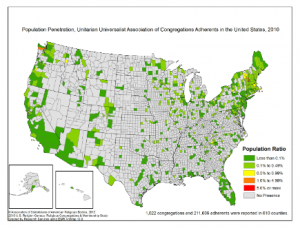The Association of Statisticians of American Religious Bodies (ASARB) has produced some interesting maps on the geographic distribution of various religious groups, as of 2010. You can search for specific religious groups, including the Unitarian Universalist Association (UUA). For the UUA, you can pull up the following types of maps: adherent change, adherent quintile, cartogram, locations, location change, penetration, etc.
I also found county-by-county data in CSV format, which I dumped into a spreadsheet, and played around with. Here’s some numbers for you to think about: Just 5 U.S. counties show a population penetration of between 1.0% and 4.99%: Nantucket County in Massachusetts (1.97%); Jefferson County in Washington (1.45%); Charlottesville County in Virginia (1.37%); Los Alamos County in New Mexico (1.19%); and Windsor County in Vermont (1.15%).
Click on the low-resolution map below (showing population penetration) to go to the ASRAB Web page where you can get high-resolution maps and other data:
Or read on for a few more facts and figures about Unitarian Universalism that I got from the ASRAB Web site:
(1) There are 15 counties (or county equivalents*) which show a UU population penetration of 0.5-0.99%:
- City of Waynesboro, Virginia* (0.94%)
- City of Manassas, Virginia* (0.92%)
- City of Fredericksburg, Virginia* (0.90%)
- Suffolk County, Massachusetts (0.75%)
- Middlesex County, Massachusetts (0.74%)
- Washington County, Vermont (0.71%)
- Arlington County, Virginia (0.64%)
- Addison County, Vermont (0.64%)
- Barnstable County, Massachusetts (0.62%)
- Transylvania County, North Carolina (0.57%)
- Latah County, Idaho (54%)
- Chittenden County, Vermont (0.53%)
- Benton County, Oregon (0.51%)
- Outagamie County, Wisconsin (0.51%)
- Tompkins County, New York (0.50%)
(* Virginia includes independent cities that are considered counties for census purposes.)
(2) Santa Clara County, California, where my UU congregation is, has a UU population penetration of only 0.06%. Congregation planters, take note: in Santa Clara County, there are just 4 UU congregations (with just 987 UUs), to serve a county population of 1,781,642. Plenty of room for growth in this county!
(3) The U.S. county with the highest number of adherents (11,075), and the largest number of congregations (33), is Middlesex County in Massachusetts. This is where I grew up, which is probably why I think of Unitarian Universalism as a mainstream religion.


Ha! I have a membership stats post in the works. Should dovetail nicely.
Interesting. As a Washingtonian, I was curious about Jefferson County. Looking at the map, I only see one congregation, but that county has a pretty low population (a lot of it is a National Park). So it’s not so much that UUism has a vibrant presence there (although the Quimper Fellowship is a lovely congregation) as it is a matter of low overall population. I wonder about these other counties you listed?
Sara, if you go to the ASARB Web site, you can download a .csv file that has the population of each county, along with the number of UUs. It’s fun to play around with these numbers in a spreadsheet.
Perhaps rather than trying to plant churches from polity instruction books (gasp, i hate to say this!), we would have more success by referencing particular clergy, leadership, liturgical materials (see my call for expanded liturgical resources based in congregations rather than think tanks) in places with similar demographics. For instance, Santa Clara County would line up with Oak Ridge, Los Alamos, maybe Houston — places where engineers have leapt into the mix. (The old Space Coast of Florida comes to mind also.) Meanwhile, there would be places that are humanities-intensive universities, where there are recreational outdoor industries, where there are urban homesteaders (which has happened in other cities in earlier times), and there are successful congregations which bloomed in these circumstances.
Sorry to comment twice but I just realized you include Addison County, Vermont. They are served by the All Souls Interfaith Gathering, whose minister is in some way UU trained, but they chart an independent course.